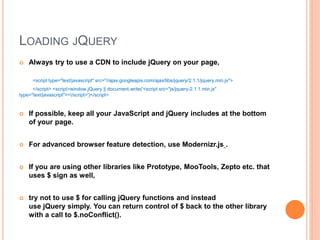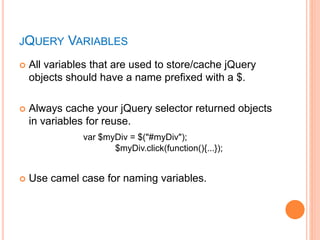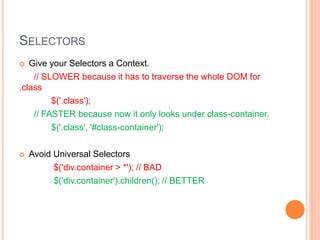jQuery Best Practice
- 1. JQUERY BEST PRACTICE AND SELECTORS Author: Chandra Shekher P © chandrashekher
- 2. TOPICS 1. Loading jQuery 2. Variables 3. Selectors 4. Dom Manipulation 5. Events 6. Ajax 7. Animations 8. Plugins 9. Chaining 10. Miscellaneous
- 3. LOADING JQUERY Always try to use a CDN to include jQuery on your page, <script type="text/javascript" src="//ajax.googleapis.com/ajax/libs/jquery/2.1.1/jquery.min.js"> </script> <script>window.jQuery || document.write('<script src="js/jquery-2.1.1.min.js" type="text/javascript"></script>')</script> If possible, keep all your JavaScript and jQuery includes at the bottom of your page. For advanced browser feature detection, use Modernizr.js . If you are using other libraries like Prototype, MooTools, Zepto etc. that uses $ sign as well, try not to use $ for calling jQuery functions and instead use jQuery simply. You can return control of $ back to the other library with a call to $.noConflict().
- 4. JQUERY VARIABLES All variables that are used to store/cache jQuery objects should have a name prefixed with a $. Always cache your jQuery selector returned objects in variables for reuse. var $myDiv = $("#myDiv"); $myDiv.click(function(){...}); Use camel case for naming variables.
- 5. SELECTORS Use ID selector whenever possible. It is faster because they are handled using document.getElementById(). When using class selectors, don't use the element type in your selector. for Performance Improvements. var $products = $("div.products"); // SLOW var $products = $(".products"); // FAST Use find for Id->Child nested selectors. The .find() approach is faster because the first selection is handled without going through the Sizzle selector engine. // BAD, a nested query for Sizzle selector engine var $productIds = $("#products div.id"); // GOOD, #products is already selected by document.getElementById() so only div.id needs to go through Sizzle selector engine var $productIds = $("#products").find("div.id");
- 6. SELECTORS Be specific on the right-hand side of your selector, and less specific on the left // Unoptimized $("div.data .gonzalez"); // Optimized $(".data td.gonzalez"); Avoid Excessive Specificity $(".data table.attendees td.gonzalez"); // Better: Drop the middle if possible. $(".data td.gonzalez");
- 7. SELECTORS Give your Selectors a Context. // SLOWER because it has to traverse the whole DOM for .class $('.class'); // FASTER because now it only looks under class-container. $('.class', '#class-container'); Avoid Universal Selectors $('div.container > *'); // BAD $('div.container').children(); // BETTER
- 8. SELECTORS Avoid Implied Universal Selectors. When you leave off the selector, the universal selector (*) is still implied. $('div.someclass :radio'); // BAD $('div.someclass input:radio'); // GOOD Don’t Descend Multiple IDs or nest when selecting an ID. ID-only selections are handled using document.getElementById() so don't mix them with other selectors. $('#outer #inner'); // BAD $('div#inner'); // BAD $('.outer-container #inner'); // BAD $('#inner'); // GOOD, only calls document.getElementById()
- 9. DOM MANIPULATION Always detach any existing element before manipulation and attach it back after manipulating it. var $myList = $("#list-container > ul").detach(); //...a lot of complicated things on $myList $myList.appendTo("#list-container"); Don’t Act on Absent Elements. // BAD: This runs three functions before it realizes there's nothing in the selection $("#nosuchthing").slideUp(); // GOOD var $mySelection = $("#nosuchthing"); if ($mySelection.length) { $mySelection.slideUp(); }
- 10. DOM MANIPULATION Use string concatenation or array.join() over .append() // BAD var $myList = $("#list"); for(var i = 0; i < 10000; i++){ $myList.append("<li>"+i+"</li>"); } // GOOD var $myList = $("#list"); var list = ""; for(var i = 0; i < 10000; i++){ list += "<li>"+i+"</li>"; } $myList.html(list); // EVEN FASTER var array = []; for(var i = 0; i < 10000; i++){ array[i] = "<li>"+i+"</li>"; } $myList.html(array.join(''));
- 11. EVENTS Use only one Document Ready handler per page. It makes it easier to debug and keep track of the behavior flow. DO NOT use anonymous functions to attach events. Anonymous functions are difficult to debug, maintain, test, or reuse. $("#myLink").on("click", function(){...}); // BAD // GOOD function myLinkClickHandler(){...} $("#myLink").on("click", myLinkClickHandler); Document ready event handler should not be an anonymous function. Once again, anonymous functions are difficult to debug, maintain, test, or reuse. $(function(){ ... }); // BAD: You can never reuse or write a test for this function. // GOOD $(initPage); // or $(document).ready(initPage); function initPage(){ // Page load event where you can initialize values and call other initializers.
- 12. EVENTS Document ready event handlers should be included from external files and inline JavaScript can be used to call the ready handle after any initial setup. <script src="my-document-ready.js"></script> <script> // Any global variable set-up that might be needed. $(document).ready(initPage); // or $(initPage); </script> DO NOT use behavioral markup in HTML (JavaScript inlining), these are debugging nightmares. Always bind events with jQuery to be consistent so it's easier to attach and remove events dynamically. <a id="myLink" href="#" onclick="myEventHandler();"> my link </a> <!-- BAD --> $("#myLink").on("click", myEventHandler); // GOOD
- 13. EVENTS When possible, use custom namespace for events. It's easier to unbind the exact event that you attached without affecting other events bound to the DOM element. $("#myLink").on("click.mySpecialClick", myEventHandler); // GOOD // Later on, it's easier to unbind just your click event $("#myLink").unbind("click.mySpecialClick"); Use event delegation when you have to attach same event to multiple elements. Event delegation allows us to attach a single event listener, to a parent element, that will fire for all descendants matching a selector, whether those descendants exist now or are added in the future. $("#list a").on("click", myClickHandler); // BAD, you are attaching an event to all the links under the list. $("#list").on("click", "a", myClickHandler); // GOOD, only one event handler is attached to the parent.
- 14. AJAX Avoid using .getJson() or .get(), simply use the $.ajax() as that's what gets called internally. DO NOT use http requests on https sites. Prefer schemaless URLs (leave the protocol http/https out of your URL) DO NOT put request parameters in the URL, send them using data object setting. // Less readable... $.ajax({ url: "something.php?param1=test1¶m2=test2", .... }); // More readable... $.ajax({ url: "something.php", data: { param1: test1, param2: test2 } });
- 15. AJAX Try to specify the dataType setting so it's easier to know what kind of data you are working with. Use Delegated event handlers for attaching events to content loaded using Ajax. Delegated events have the advantage that they can process events from descendant elements that are added to the document at a later time $("#parent-container").on("click", "a", delegatedClickHandlerForAjax); Use Promise interface $.ajax({ ... }).then(successHandler, failureHandler); // OR var jqxhr = $.ajax({ ... }); jqxhr.done(successHandler); jqxhr.fail(failureHandler);
- 16. AJAX Sample Ajax Template: var jqxhr = $.ajax({ url: url, type: "GET", // default is GET but you can use other verbs based on your needs. cache: true, // default is true, but false for dataType 'script' and 'jsonp', so set it on need basis. data: { }, // add your request parameters in the data object. dataType: "json", // specify the dataType for future reference jsonp: "callback", // only specify this to match the name of callback parameter your API is expecting for JSONP requests. // statusCode: { // if you want to handle specific error codes, use the status code mapping settings. 404: handler404, 500: handler500 } }); jqxhr.done(successHandler);
- 17. EFFECTS AND ANIMATIONS Adopt a restrained and consistent approach to implementing animation functionality. DO NOT over-do the animation effects until driven by the UX requirements. 1 Try to use simple show/hide, toggle and slideUp/slideDown functionality to toggle elements. 2 Try to use predefined animations durations of "slow", "fast" or 400 (for medium).
- 18. CHAINING Use chaining as an alternative to variable caching and multiple selector calls. $("#myDiv").addClass("error").show(); Whenever the chain grows over 3 links or gets complicated because of event assignment, use appropriate line breaks and indentation to make the code readable. $("#myLink") .addClass("bold") .on("click", myClickHandler) .on("mouseover", myMouseOverHandler) .show(); For long chains it is acceptable to cache intermediate objects in a variable.
- 19. PLUGINS Always choose a plugin with good support, documentation, testing and community support. Check the compatibility of plugin with the version of jQuery that you are using. Any common reusable component should be implemented as a jQuery plugin
- 20. MISCELLANEOUS Use Object literals for parameters. $myLink.attr("href", "#").attr("title", "my link").attr("rel", "external"); // BAD, 3 calls to attr() // GOOD, only 1 call to attr() $myLink.attr({ href: "#", title: "my link", rel: "external" }); Do not mix CSS with jQuery. $("#mydiv").css({'color':red, 'font-weight':'bold'}); // BAD $("#mydiv").addClass("error"); // GOOD DO NOT use Deprecated Methods. It is always important to keep an eye on deprecated methods for each new version and try avoid using them.Click here for a list of deprecated methods. Combine jQuery with native JavaScript when needed. See the performance difference for the example given below $("#myId"); // is still little slower than... document.getElementById("myId");









![DOM MANIPULATION
Use string concatenation or array.join() over .append()
// BAD
var $myList = $("#list");
for(var i = 0; i < 10000; i++){
$myList.append("<li>"+i+"</li>");
}
// GOOD var $myList = $("#list");
var list = "";
for(var i = 0; i < 10000; i++){
list += "<li>"+i+"</li>";
}
$myList.html(list);
// EVEN FASTER
var array = [];
for(var i = 0; i < 10000; i++){
array[i] = "<li>"+i+"</li>";
}
$myList.html(array.join(''));](https://image.slidesharecdn.com/jquerybestpracticeandselectors-150425054758-conversion-gate01/85/jQuery-Best-Practice-10-320.jpg)









